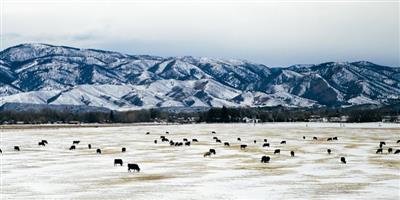Ensuring that cattle and any other livestock being pastured in exposed areas have adequate access to shelter to escape the wind and cold is especially important. Livestock grazing open crop residue fields or large pastures can be left exposed during extreme bouts of cold, and producers should try to mitigate these effects. In addition to cold, wind chills will increase heat loss dramatically by penetrating even the thickest winter coats, increasing livestock energy requirements to maintain body temperature, thus driving up feed costs. When temperatures drop below 30 degrees Fahrenheit, energy requirements increase approximately 13% for every 10 degree decrease in windchill, and cattle can experience cold stress below 18 degrees Fahrenheit.
Design Considerations
There are several considerations for designing windbreaks, and the requirements for sizing will largely depend on the number of animals that will be utilizing the structure for shelter. It is important to understand that windbreaks and shelter belts do not eliminate wind, they simply redirect it, and in many cases wind velocity may increase as it is redirected around a break, especially if the structure is solid in nature such as a repurposed grain bin or plywood fence. Whether windbreaks are permanent or temporary, they must be sturdy enough to withstand high winds and the accompanying force those winds exert. Posts for permanent structures should be at least 8’ thick and extend 3-5’ below the frost line. For mobile structures, wide bases at least 1.5 times the height and constructed with heavy materials are necessary to prevent tipping from high winds or cattle rubbing. Orientation of windbreaks should be positioned perpendicular to the wind direction, although V-shaped windbreaks are common in areas with multiple wind directions. Deviations of up to 30-degrees in windbreak angle still provide adequate protection.
A common rule of thumb is to allocate 25-square feet of protection per cow, or 1 foot of fence length per cow. The protected zone of a windbreak will extend out to the leeward side by 8-15 heights of the structure with a reduction of wind speed of approximately 50%. Previous research has identified an ideal ratio of length to height of 10:1, so for example a 10’ windbreak should be a minimum of 100’ long for maximal protection. Structures should be placed at least 75 feet upwind of any roads, alleys, or buildings to reduce the impact of high winds and drifting snow.
Structure Density
One often overlooked component of windbreak design is the density of the structure. If a structure is solid, initial windspeed reduction is greater, but drifting is often more severe at the edges of the windbreak as result of increased downwind speed. Once the sides of a solid windbreak are drifted, the wind simply goes up and over the top, with wind and precipitation descending on the now unprotected area and reducing its effectiveness. Livestock windbreaks should have a porosity of 25-33%, meaning 67-75% of the structure should be solid, with the remainder being open spaces that allow a small amount of wind to pass through at a reduced velocity. This increases the amount of wind coming up and over the top of the structure and increases the effective coverage area provided downwind. This means that if you’re using 6” boards to build your windbreak, spacing them 2” apart would provide 25% porosity, and a 3” gap between would provide 33% porosity, etc. Creating space at the bottom of the structure of 4-12” to allow wind to pass through at ground level can also reduce drifting around the base of windbreaks.
Living Shelterbelts
Living shelterbelts are common in parts of the South Dakota, and the same principles generally apply. The appropriate density of a living windbreak will depend on the type of shrubs and trees utilized. It is always recommended to consult with an Extension Specialist or other expert when considering species selection to prevent the introduction of invasive species and to maximize effectiveness when considering installing or enhancing living shelter belts, especially when considering installation on native rangelands or other pasture areas. Information on potential technical and financial support for such projects can also be obtained from local USDA service centers throughout the state.
In Summary
The natural terrain, wind direction, and available windbreaks will vary largely between operations, so it is important to remain flexible. The design of a windbreak should be carefully evaluated as to how it will impact production. While installing windbreaks can represent a large investment of time and resources, benefits to livestock and the producer are undeniable and should be considered annually for every grazing situation, not only during severe winter-conditions.
###
Kiernan Brandt – South Dakota State University
SDSU Extension/iGrow


